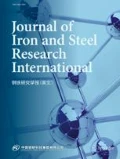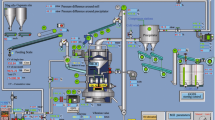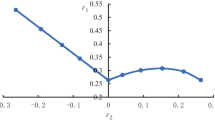Abstract
An empirical dynamic model of burn-through point (BTP) in sintering process was developed. The K-means clustering was used to feed distribution according to the cold bed permeability, which was estimated by the superficial gas velocity in the cold stage. For each clustering, a novel genetic programming (NGP) was proposed to construct the empirical model of the waste gas temperature and the bed pressure drop in the sintering stage. The least square method (LSM) and M-estimator were adopted in NGP to improve the ability to compute and resist disturbance. Simulation results show the superiority of the proposed method.
Similar content being viewed by others
References
Meng J E, Liao J, Lin J. Fuzzy Neural Networks-Based Quality Prediction System for Sintering Process [J]. IEEE Transaction on Fuzzy System, 2000, 8(3): 314.
Venkataramana R, Gupta S S, Kapur P C. A Combined Model for Granule Size Distribution and Cold Bed Permeability in the Wet Stage of Iron Ore Sintering Process [J]. International Journal of Mineral Processing, 1999, 57(1): 43.
Kown W H, Kime Y H, Lee S J. Event-Based Model and Control Algorithm for Burnthrough Point in Sintering Processes [J]. IEEE Transactions on Control Systems Technology, 1999, 7(1): 31.
Yong H K, Wook H K. An Application of Min-max Generalized Predictive Control to Sintering Processes [J]. Control Engineering Practice, 1998, 6(8): 999.
Zhang J H, Xie A G, Shen F M. Multi-Objective Optimization and Analysis Model of Sintering Process Based on BP Neural Network [J]. Journal of Iron and Steel Research, International, 2007, 14(2): 1.
Long G M, Fan X H, Jiang T, et al. Research and Application of Expert System Skeleton for Controlling Sintering Process [J]. Journal of Iron and Steel Research, International, 2008, 15(5): 1.
Zheng L M. The Principle and Mathematical Model of Microcomputer System Controlling Sintering Burn-Through Point [J]. Metallurgical Industry Automation, 1989, 13 (6): 3.
Hinkley J, Waters A G, Litster J D. An Investigation of Pre-Ignition Air Flow in Ferrous Sintering [J]. International Journal of Mineral Processing, 1994, 42(1): 37.
Koza J. Genetic Programming: on the Programming of Computers by Means of Natural Selection [M]. Cambridge; MIT Press, 1992.
Wu Y L, Lu J G, Sun Y X. A Segregated Genetic Programming for Bioprocess Modelling With Outliers [J]. Asia-Pacific Journal of Chemical Engineering, 2008, 3(6): 606.
Author information
Authors and Affiliations
Corresponding author
Additional information
Foundation Item: Item Sponsored by National Natural Science Foundation of China (60736021, 21076179); National High-Technologies Research and Development Program of China (863 Program) (2006AA04Z184, 2007AA041406); Key Technologies Research and Development Program of Zhejiang Province of China (2006C11066, 2006C31051); Natural Science Foundation of Zhejiang Province of China (Y4080339)
Rights and permissions
About this article
Cite this article
Shang, Xq., Lu, Jg., Sun, Yx. et al. Data-driven prediction of sintering burn-through point based on novel genetic programming. J. Iron Steel Res. Int. 17, 1–5 (2010). https://doi.org/10.1016/S1006-706X(10)60188-4
Received:
Published:
Issue Date:
DOI: https://doi.org/10.1016/S1006-706X(10)60188-4




